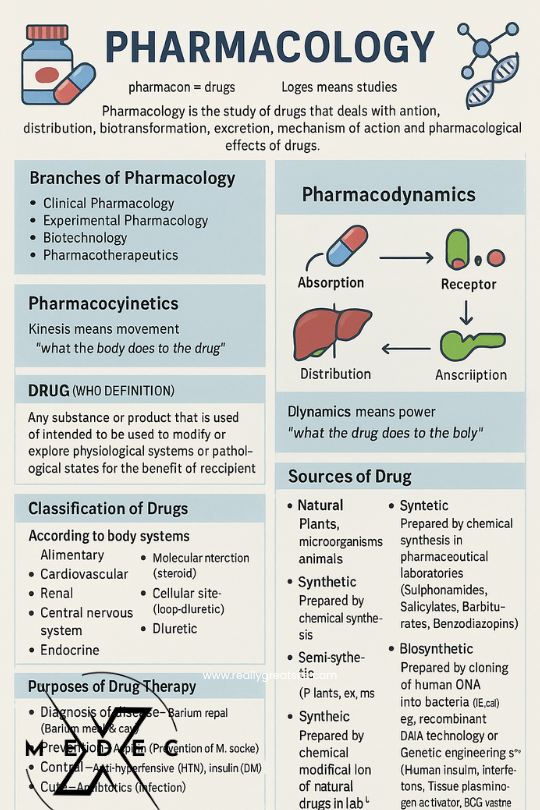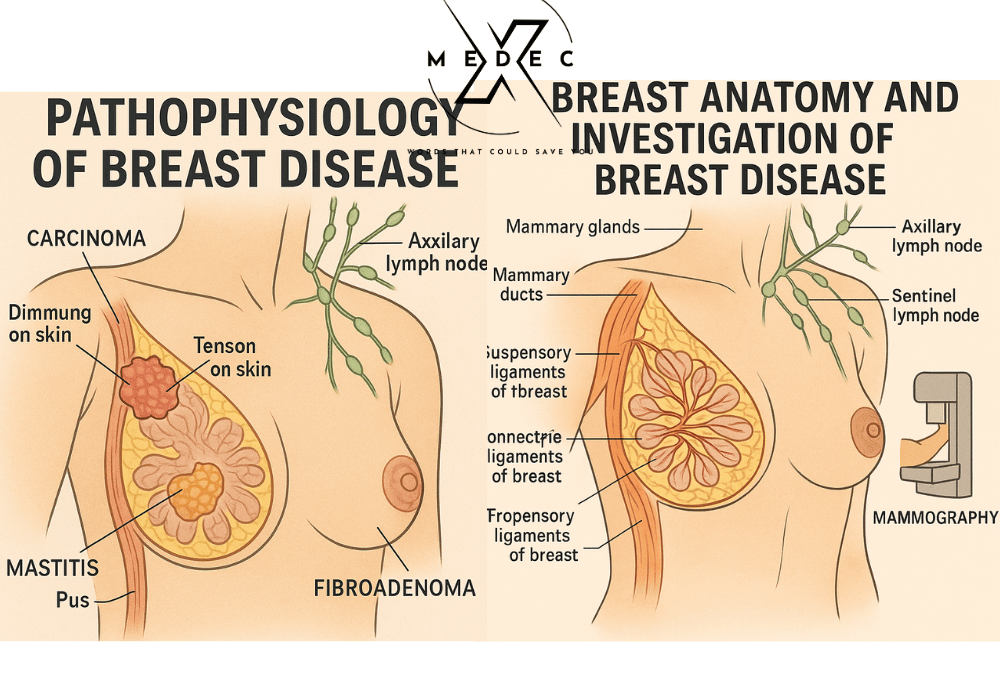Introduction Of Pharmacology

Topic: Introduction of Pharmacology
Pharmacon means drugs
Logos means studies
Pharmacology is the study of drugs that deals with absorption, distribution, biotransformation, excretion, mechanism of action and pharmacological effects of drugs.
Branches of Pharmacology
Two main branches:
- Pharmacokinetics
- Pharmacodynamics
Others:
- Clinical Pharmacology_ It is the scientific study of drugs in man (healthy volunteers & patients)
- Experimental Pharmacology_ It is the study of drug effects in laboratory animals
- Biotechnology_ It is the production of drugs or other useful products by biological means (Recombinant DNA technology)
- Pharmacotherapeutics_ It is the use of drugs for the prevention & treatment of diseases
- Toxicology_ It deals with the adverse reactions of drugs and their treatment
- Pharmacy_ It is the collection, compounding and dispensing of drugs
- Pharmacognosy_ It is the isolation and characterization of drugs from natural sources
- Pharmacogenetics_ It is the study of genetic influences on responses to drugs.
- Pharmacogenomics_ It is the use of genetic information to guide the choice of drug therapy on an individual basis.
- Pharmacoepidemiology_ It is the study of drug effects at the population level.
- Pharmacoeconomics- It is to quantify in economic terms the cost and benefit of drugs used therapeutically.

Pharmacokinetics
- Kinesis means movement.
- “What the body does to the drug”
- It is the branch of Pharmacology that deals with absorption, distribution, biotransformation and excretion of drugs.
Pharmacodynamics
- Dynamics means power
- “What the drug does to the body”
- It is the branch of Pharmacology that deals with the mechanism of action and pharmacological effects of drugs.
Introduction of pharmacology continues:
Drug(WHO definition)
Any substance or product that is used or intended to be used to modify or explore physiological systems or pathological states for the benefit of the recipient.
Classification of drugs
According to body systems:
- Alimentary
- Cardiovascular
- Renal
- Central nervous system
- Endocrine
According to the site of action:
- Molecular interaction (steroid)
- Cellular site (loop diuretic)
According to molecular structure:
- Glycosides
- Alkaloids
- Steroids
According to the therapeutic effect:
- Antihypertensive
- Antiemetic
- Antibiotic
- Diuretic
Purposes of Drug Therapy
- Diagnosis of disease_ Barium sulphate (Barium meal X-ray)
- Prevention_ Aspirin (Prevention of MI, stroke)
- Control_ Anti-hypertensive (HTN), Insulin (DM)
- Cure_ Antibiotics (infection)
Sources of Drug
- Natural_ Plants, microorganisms, animals, minerals
- Synthetic_ Prepared by chemical synthesis in pharmaceutical laboratories (Sulphonamides, Salicylates, Barbiturates, Benzodiazepines)
- Semi-synthetic_ Prepared by chemical modification of natural drugs in lab (Ampicillin from Penicillin-G)
- Biosynthetic_ Prepared by cloning of human DNA into bacteria (E.Coli). Eg: recombinant DNA technology or Genetic engineering (Human Insulin, Interferons, Tissue plasminogen activator, BCG vaccine, Hepatitis-B Vaccine)
Plant Source
- Primary source (berries, bark, leaves, resin, roots)
- Alkaloids_ Morphine from Poppy capsules
- Glycosides_ Digoxin from Digitalis purpurea
- Oil_ Castor oil from castor seeds
- Gum & mucilage_ Agar & psyllium seeds (laxative)
Alkaloids
- Alkaloid means Alkali like substance.
- They are basic nitrogenous compounds of plant origin & produce salt when combine with acids.
Examples:
- Morphine from Poppy capsules.
- Atropine from belladonna leaves.
- Quinine from Cinchona bark.
Glycosides
- Non-nitrogenous, colourless, crystalline, solid compounds, composed of sugar & non-sugar part (aglycon)
Examples:
- Digoxin & digitoxin from leaves of purple foxgloves (Digitalis purpurea)
- Salicylic acid from willow bark
Animal Source
- From the glands, organs & tissues of animals
Examples:
- Insulin from Pig or Ox pancreas.
- Thyroxine from the Pig or Ox thyroid gland.
- Heparin from Pig or Ox liver.
- Cod Liver Oil from Cod Fish Liver
- Anti-tetanus & anti-diphtheria toxoid from Horse globulin
Microorganism source
- Actinomycetes (fungi): Actinomycin, Amphotericin, Chloramphenicol, Erythromycin,
- Aspergillate (fungus): Penicillin, Cephalosporin, Griseofulvin
- Bacillus (Bacteria): Bacitracin, Polymyxin B
Mineral source:
Calcium, Aluminium, Sodium, Potassium, Zinc, Iron, liquid paraffin.
Pharmacopoeia
- An official book published by an authorised body in a country containing description of commonly used drugs with their sources, properties, uses, doses, purity and potency.
- It is revised every five years.
Some Pharmacopoeias
- B.P._ British Pharmacopoeia
- U.S.P. _ United States Pharmacopoeia
- E.P_ European Pharmacopoeia
- J.P_ Japanese pharmacopoeia
- I.P._ Indian Pharmacopoeia
(There is no Pharmacopoeia in Bangladesh, so it follows the British Pharmacopoeia)
Formulary
- A book that contains indications, dose, dosage forms, contraindications, precautions, adverse effects of drugs that are available for clinical use in a country.
- Bangladesh follows BDNF (Bangladesh National Formulary).
Nomenclature(Names of Drugs)
Chemical names
- Shows the chemical composition of the drug
- Unsuitable for prescribing as it is long and complicated
Non-proprietary (generic) name
- Name given by official bodies (WHO)
- Typically derived from the chemical name Shorter nameUsed in pharmacopoeias
- The same name is used in all countries
Proprietary (trade) name
- The name registered by the manufacturer has several trade names (depending on the number of manufacturers). It can be confusing (similar names of different drugs by different manufacturers). The first letter of the name is capitalised
- Chemical name: 2-(p-isobutylphenyl) propionic acidGeneric name: IbuprofenTrade (brand) names:Reumafen (Beximco)Profen (Acme)
- Inflam (Aventis)
According to the National Center for Biotechnology Information, pharmacology is the study of drug interactions with living systems, covering drug absorption, distribution, metabolism, excretion, and mechanism of action.
You may also like apart from Introduction Of pharmacology:


